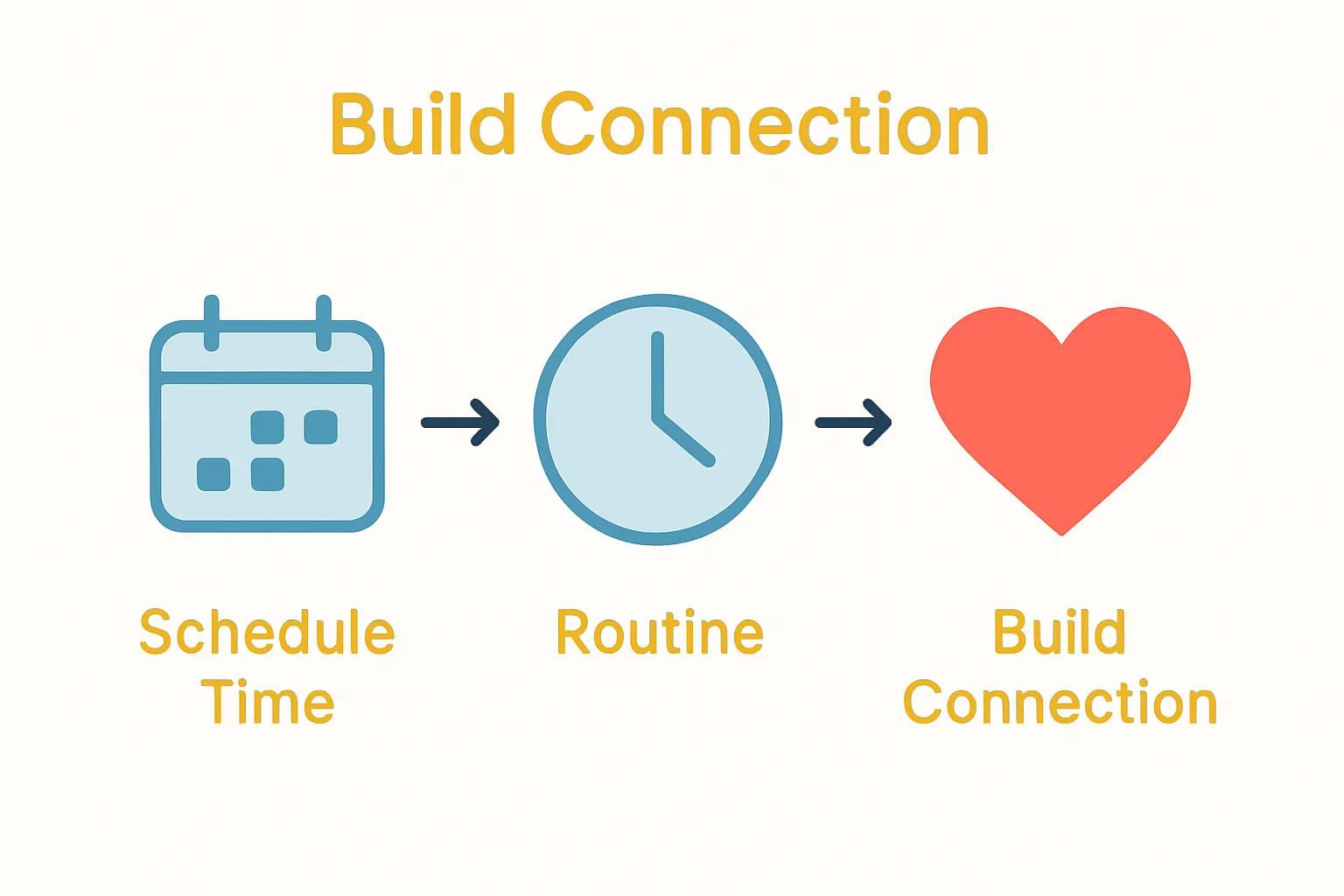Trying to reconnect with your husband can feel overwhelming, especially when daily routines seem to pull you further apart. Research shows that couples who consistently invest in quality time together report up to 60 percent higher relationship satisfaction compared to those who do not. Most people think you need grand romantic gestures to revive intimacy, but genuine reconnection often starts with a simple, honest look at your relationship’s emotional patterns. Surprising shifts happen when small steps lead to big changes.
Table of Contents
- Step 1: Assess Your Current Relationship Dynamics
- Step 2: Identify Common Interests And Goals
- Step 3: Schedule Quality Time Together
- Step 4: Communicate Openly And Honestly
- Step 5: Reinforce Positive Interactions Regularly
Quick Summary
| Key Point | Explanation |
|---|---|
| 1. Self-Reflect on Relationship Dynamics | Assess your marriage’s emotional landscape through honest self-reflection to understand connection points and disconnection zones. |
| 2. Identify Shared Interests and Goals | Engage in open conversations to discover mutual passions and align future aspirations, strengthening your partnership. |
| 3. Schedule Intentional Quality Time | Dedicate regular, distraction-free time for shared experiences to deepen emotional intimacy and connection. |
| 4. Communicate Openly and Honestly | Foster transparent dialogue through regular emotional check-ins to enhance understanding and vulnerability in your relationship. |
| 5. Reinforce Positive Interactions Regularly | Practice daily expressions of appreciation and acknowledgment to create a nurturing emotional environment and strengthen bonds. |
Step 1: Assess Your Current Relationship Dynamics
Reconnecting with your husband starts with honest self-reflection and understanding your current relationship landscape. This critical first step involves examining your marriage’s emotional terrain without judgment or defensiveness. Many couples struggle to rebuild intimacy because they skip this foundational assessment.
Mapping Your Relationship Dynamics
Begin by creating a comprehensive emotional inventory of your marriage. Think of this as a relationship diagnostic process where you objectively evaluate connection points, communication patterns, and potential disconnection zones. Ask yourself critical questions: When was the last time you and your husband felt truly connected? What specific interactions trigger distance between you? Are there recurring communication breakdowns that prevent genuine understanding?
Carry out this assessment through intentional self-observation. Notice your emotional reactions during interactions with your husband. Track moments of tension, disconnect, and potential misunderstandings. Read our guide on nurturing your marriage for additional insights into relationship mapping.
Documenting your observations can be transformative. Consider keeping a private journal where you record interaction patterns without blame or criticism. Focus on understanding rather than proving who is right or wrong. Write down specific scenarios that create emotional distance and moments of genuine connection.
Identifying Relationship Roadblocks
Understanding potential roadblocks requires vulnerability and courage. Common barriers include unresolved resentments, different communication styles, unmet emotional needs, and accumulated stress. Recognize that identifying these barriers is not about assigning fault but creating pathways for healing.
As you assess your relationship dynamics, remain compassionate with yourself and your husband. The goal is not perfection but genuine understanding. By carefully mapping your relationship’s emotional landscape, you create a strategic foundation for meaningful reconnection. Your honest self-reflection becomes the first powerful step toward rebuilding intimacy and strengthening your marital bond.
Successful completion of this step means you have:
Here is a checklist table summarizing key completion criteria for each step in reconnecting with your husband.
| Step | Completion Criteria |
|---|---|
| Step 1: Assess Relationship Dynamics | Document interaction patterns, identify triggers and disconnection zones, develop a non-judgmental perspective, create a roadmap for improvement |
| Step 2: Identify Common Interests and Goals | Find 2-3 mutual interests, create a vision board, understand personal aspirations, set framework for planning together |
| Step 3: Schedule Quality Time Together | Set a weekly connection time, rotate planning, create framework for meaningful interactions, protect shared time |
| Step 4: Communicate Openly and Honestly | Hold regular check-ins, practice active listening, express feelings constructively, build safe communication space |
| Step 5: Reinforce Positive Interactions Regularly | Start gratitude practice, create appreciation rituals, increase positive interactions, acknowledge contributions |
- Objectively documented relationship interaction patterns
- Identified specific emotional triggers and disconnection zones
- Developed a compassionate, non-judgmental perspective on your marriage’s current state
- Created a personal roadmap for potential areas of improvement
Step 2: Identify Common Interests and Goals
Reigniting connection with your husband requires discovering and nurturing shared passions that transcend daily routines. This step transforms disconnected coexistence into intentional partnership by uncovering mutual interests and aligning future aspirations.
Start by scheduling a dedicated conversation outside your normal environment. Choose a neutral setting like a quiet cafe or peaceful park where you can speak without household distractions. Approach this dialogue with genuine curiosity and openness. Your goal is not to compete or debate but to understand and explore.
Exploring Shared Passions
Begin by reflecting on experiences you both enjoyed in the past. What activities made you laugh together? When did you feel most connected? These memories are crucial signposts pointing toward rekindled intimacy. Some couples discover shared interests in unexpected places – perhaps a forgotten hobby, a travel dream, or a mutual skill you could develop together.
Explore our guide on building trust in marriage to understand how shared goals create deeper emotional bonds. Mutual interests act as relationship glue, providing opportunities for joint experiences and meaningful conversation.
Consider creating a shared vision board representing collective dreams. This could include travel destinations, personal development goals, family objectives, or creative projects. Visual representations help transform abstract discussions into tangible, exciting possibilities.
Strategic Goal Alignment
Beyond recreational interests, discuss long-term life goals. Where do you both see yourselves in five or ten years? What personal and collective achievements matter most? Genuine alignment happens when individual aspirations complement rather than compete.
Communicate your individual goals transparently. Listen without judgment. Your objective is discovering intersection points where your personal dreams can harmonize. This might involve career support, financial planning, parenting strategies, or personal growth commitments.
Successful completion of this step means you have:
- Identified at least 2-3 mutual interests or potential shared activities
- Created a preliminary vision board representing collective goals
- Developed a deeper understanding of each other’s personal aspirations
- Established a framework for future collaborative planning
Remember, reconnection is a journey of continuous discovery. Approach this process with patience, empathy, and genuine enthusiasm for growing together.
Step 3: Schedule Quality Time Together
Reconnecting requires deliberate, structured investment in shared experiences that go beyond routine interactions. Quality time is not about grand gestures but consistent, meaningful engagement that rebuilds emotional intimacy.
Start by creating a dedicated relationship calendar – a strategic planning tool for intentional connection. This isn’t about scheduling every minute but establishing predictable opportunities for genuine interaction. According to research from the National Institutes of Health, consistent quality time significantly enhances relationship satisfaction.

Designing Meaningful Interactions
Implement a weekly “connection date” that alternates planning responsibilities between you and your husband. The planner designs an experience focusing on mutual enjoyment, not just entertainment. These dates can range from low-key activities like cooking together to more elaborate outings. The key is maintaining flexibility and genuine engagement.
Consider creating a framework for your connection dates:
- One partner plans the activity completely
- No work or household discussions allowed
- Electronic devices remain silent or off
- Focus on enjoying each other’s company
Be creative with your time together. Shared experiences don’t always require leaving home. Some of the most profound connections happen through simple, intentional activities like preparing a meal together, taking an evening walk, or learning a new skill as partners.
Overcoming Common Connection Barriers
Recognize that scheduling quality time might feel awkward initially. Many couples struggle with feeling forced or artificial when first implementing structured connection time. Embrace this discomfort as part of the rebuilding process. The goal is not perfection but consistent effort.
Explore our guide on building trust in marriage for additional strategies in creating meaningful interactions. Remember that quality time is about presence, not performance. Listen actively, share vulnerably, and remain open to spontaneous moments of connection.
Successful completion of this step means you have:
- Established a weekly dedicated connection time
- Created a rotating planning system for dates
- Developed a framework for meaningful interactions
- Committed to protecting and prioritizing this shared time
Approach these connection opportunities with curiosity, patience, and a genuine desire to rediscover your partner. Consistent, intentional time together becomes the foundation for deeper understanding and renewed intimacy.

Step 4: Communicate Openly and Honestly
Authentic communication transforms relationship dynamics, turning disconnection into genuine understanding. This step involves creating a safe emotional landscape where vulnerability becomes strength and honest dialogue replaces surface-level interactions.
According to research from the American Psychological Association, effective communication is the cornerstone of relationship health. Begin by establishing a judgment-free dialogue zone where both partners feel secure expressing emotions without fear of criticism or immediate problem-solving.
Creating Safe Communication Spaces
Design intentional communication rituals that move beyond routine conversations. Schedule weekly “emotional check-in” sessions where each partner gets uninterrupted time to share feelings, concerns, and aspirations. The listener’s role is pure reception – no interrupting, defending, or offering immediate solutions.
Learn more about communication techniques for couples to enhance your dialogue skills. Practice active listening techniques: maintain eye contact, use affirming body language, and reflect back what you’ve heard to demonstrate genuine understanding.
Develop a communication framework that prioritizes emotional transparency. Use “I” statements that express personal feelings without accusation. Instead of saying “You never listen,” try “I feel unheard when our conversations seem one-sided.” This approach invites collaboration rather than triggering defensive responses.
Navigating Difficult Conversations
Recognize that honest communication includes discussing uncomfortable topics. Challenging conversations are opportunities for growth, not relationship threats. Approach sensitive subjects with compassion, acknowledging that vulnerability requires courage from both partners.
Create ground rules for difficult discussions:
- Set a specific time and neutral location
- Commit to respectful dialogue
- Take breaks if emotions become overwhelming
- Focus on understanding, not winning
Successful completion of this step means you have:
- Established regular emotional check-in sessions
- Practiced active, non-defensive listening
- Developed skills for expressing feelings constructively
- Created a safe space for authentic communication
Remember, rebuilding communication is a skill that improves with consistent, patient practice. Approach each conversation as an opportunity to reconnect and understand each other more deeply.
Step 5: Reinforce Positive Interactions Regularly
Rebuilding connection requires intentional celebration of small, meaningful moments. This step transforms relationship dynamics by systematically amplifying positive interactions, creating a nurturing emotional environment that naturally draws partners closer.
According to research from the National Institutes of Health, consistent expressions of appreciation significantly enhance relationship satisfaction. The goal is to create a positive feedback loop that gradually rewires your relationship’s emotional infrastructure.
Designing Intentional Appreciation Strategies
Implement a daily gratitude practice specifically focused on your husband. This goes beyond generic compliments – acknowledge specific actions, character traits, and efforts that often go unrecognized. Notice and verbalize moments of competence, kindness, and support that demonstrate his unique value.
Explore our guide on building trust in marriage to understand how consistent positive reinforcement transforms relationships. Create personalized appreciation rituals that feel authentic to your connection. This might involve morning text messages highlighting something you admire, unexpected notes of recognition, or verbal acknowledgments during shared moments.
Develop a systematic approach to positive reinforcement. Track and celebrate small wins – whether it’s handling a challenging work situation, supporting family needs, or demonstrating emotional intelligence. Your consistent recognition builds emotional safety and motivates continued positive behavior.
Creating Meaningful Positive Interactions
Positive reinforcement extends beyond verbal appreciation. Design physical and experiential ways of showing connection. Unexpected gestures like spontaneous hugs, surprise date nights, or supporting his personal goals communicate deeper levels of commitment.
Establish clear appreciation practices:
- Daily verbal or written acknowledgment
- Weekly intentional connection moments
- Monthly celebration of mutual achievements
- Consistent physical affection
Successful completion of this step means you have:
- Developed a consistent gratitude practice
- Created personalized appreciation rituals
- Increased frequency of positive interactions
- Demonstrated tangible recognition of your husband’s contributions
Remember, positive reinforcement is a skill that deepens with practice. Approach this step with genuine curiosity and warmth, allowing your appreciation to become a natural, transformative force in your relationship.
Ready to Rebuild Your Marriage Connection?
If you feel the distance growing between you and your husband, you are not alone. Many readers struggle with emotional disconnect, communication barriers, and the challenges of rebuilding intimacy. The article you just explored gives you real steps for mapping your relationship dynamics, aligning your goals, prioritizing quality time, and learning open communication. But sometimes, knowing how to start is not enough. You need daily encouragement and practical examples to keep moving forward.
Explore Daily Relationship Wisdom for proven insights and strategies specifically designed to help men reconnect with their partners and strengthen lasting bonds.

Join the movement at WiseHusband.com and take advantage of our collection of Daily Wisdom articles. Discover actionable tools to reinforce positive interactions, break unhealthy cycles, and become the wise husband your marriage deserves. Do not let another day pass without investing in the connection that means the most. Start your journey to a stronger, more fulfilling partnership now.
Frequently Asked Questions
How can I assess my current relationship dynamics with my husband?
Begin by reflecting on your emotional interactions and evaluating your connection points, communication patterns, and disconnection zones. Keeping a private journal can help document these observations objectively without judgment.
What activities can help rekindle our connection?
Consider exploring shared interests and hobbies that you both enjoyed in the past. Schedule conversations to discuss these mutual passions, and think about creating a shared vision board to visualize your goals together.
How often should we schedule quality time together?
Aim for a weekly dedicated connection time. Establish a routine to engage in meaningful activities that foster genuine interaction, ensuring to alternate planning responsibilities between you and your husband.
What are the best ways to foster open communication with my husband?
Create a safe space for dialogue by scheduling regular emotional check-in sessions. Use active listening techniques and focus on expressing your feelings through ‘I’ statements to promote understanding and connection.
